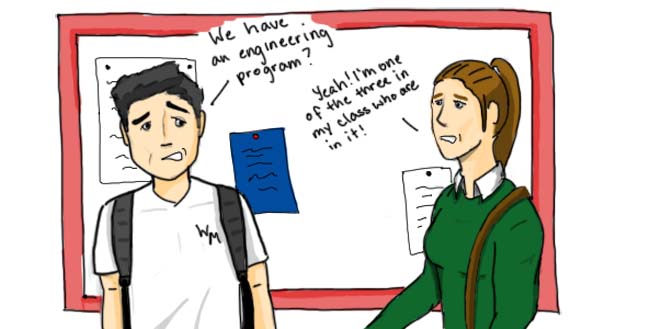You wouldn’t know it from the Office of Undergraduate Admissions, but the College of William and Mary has a place for engineers. Although the College lacks an engineering major, students seeking to obtain an engineering degree can apply for a joint program with Columbia University: Students attend the College for three or four years and Columbia for two years, earning a degree at the College and an engineering degree at Columbia. With a mere three applicants a year, the College should further promote this program to prospective and current students.
Students would benefit from a liberal arts and engineering background. Sciences and humanities students often separate themselves into two academic camps with increasingly specialized knowledge, lacking the overlap necessary for a well-rounded education.
Engineers should be able to write well and government majors shouldn’t have to wince while recalling the three laws of thermodynamics. Students with liberal arts and engineering degrees will not only know more about the world, but will have a greater capacity to appreciate its wonders. They will not only have more useful skills, but will be able to think critically, logically and, hopefully, creatively.
Graduates with dual degrees in liberal arts and engineering from the College and Columbia would also be valuable to employers. According to US News and World Report, the unemployment rate for engineers was below 2 percent. The unemployment rate for college graduates in other professions is double that at 3.9 percent.
While enrollment is still low, the College should recognize that there is interest in the program. Professor Eugeniy Mikhailov, advisor to the program, told The Flat Hat he had received nearly 200 emails from students, parents and high school students requesting more information about it. Yet, it remains obscure. The College shouldn’t lose prospective students who are attracted to its quality liberal arts education because they are deterred by its lack of an engineering program. If the College touted its joint program with Columbia, it could reel in some of those students.
A student’s involvement in the program isn’t predetermined the way the St. Andrews program is: Students can apply as late as their junior or senior year as long as they have taken the necessary course requirements. Math and science professors could inform their students about this program, and advisors could encourage advisees interested in engineering to consider the program. Presenting this option to students throughout their college careers might make them more likely to pursue it.
Of course, students would rightfully have some reservations about participating in the program. While students would earn two separate degrees, it would require at least one additional year of undergraduate study. The financial cost might be too much for some students, especially for out-of-state students and those planning to attend graduate school. It all depends on students’ priorities and, for some, it may not be worth it.
The College would be doing itself and its students a disservice if it didn’t better publicize the program. Being a TWAMP and being an engineer need not be mutually exclusive.

